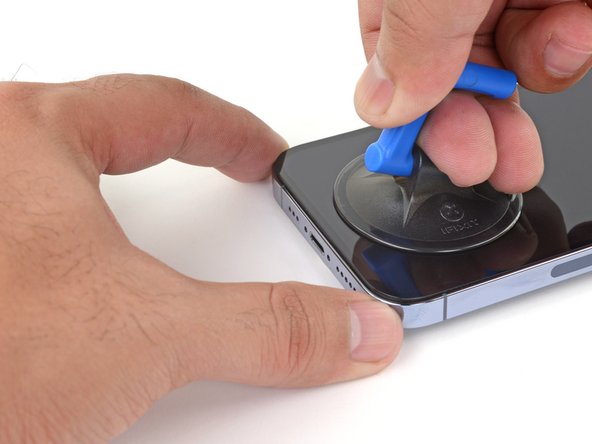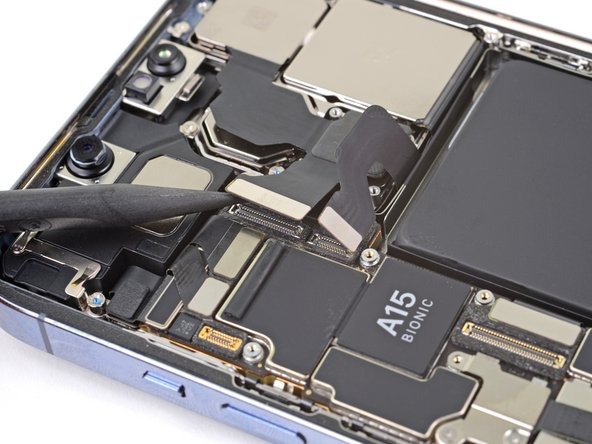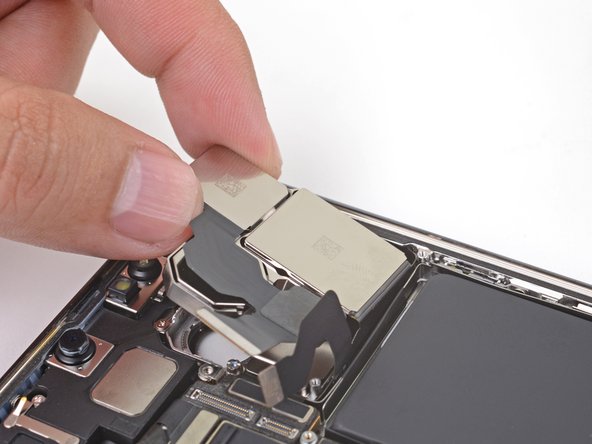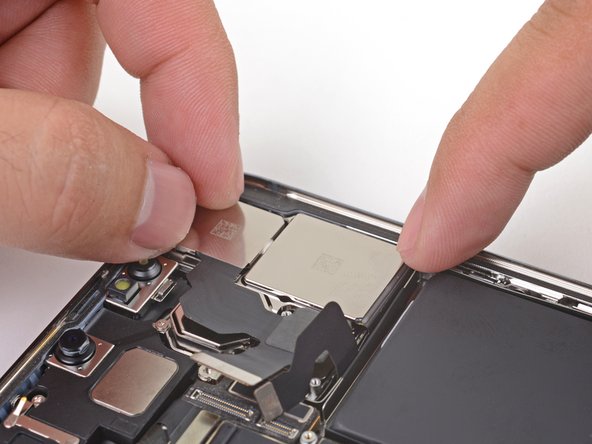iPhone 13 Pro Rear-Facing Camera Replacement
Duration: 45 minutes
Steps: 31 Steps
Ready to swap out the rear-facing cameras on your iPhone 13 Pro? No worries, we've got you covered! The camera modules come as one piece, so replacing the whole unit is a breeze. Pro tip: If you're running iOS 18 or newer, you can easily calibrate the new camera with Apple's Repair Assistant to make sure everything's perfectly in sync.
Step 1
Heads up! Before diving in, make sure your iPhone battery is below 25%. A charged lithium-ion battery can turn into a firecracker if it gets punctured. Safety first, folks!
Opening up the iPhone's display? Just a heads up, that could mess with its waterproof seals! Make sure you've got some replacement seals handy before diving into this step, or be extra careful to keep your device away from any liquid if you put it back together without swapping those seals out.
- Alright, let’s get started by turning off your iPhone. Safety first, right?
- Now, grab your pentalobe P2 screwdriver and remove the two 6.8 mm screws along the bottom edge of your device. Don't let them roll away!
Step 2
Don’t let your pick go rogue! Mark how deep is safe so it doesn’t wander in too far and mess with your device.
Feeling extra precise? Mark each corner of your pick with different depths for the ultimate control.
Or, try taping a coin 3 mm from the tip—makeshift depth guard, activated.
- Mark the opening pick 3 mm from the tip using a permanent marker to keep your pry game on point.
Step 3
Pop on some safety glasses—your eyes deserve protection from any rogue glass bits that might try to make an entrance during your repair adventure.
If your iPhone screen is cracked, keep the shards in check and avoid any ouch moments by taping over the glass before you start fixing it.
If the suction cup won’t stick, don’t sweat it—just give it a little superglue love to hold it in place.
- Start by laying down some overlapping strips of clear packing tape across the iPhone's screen until the entire face is nicely covered. It's like giving your phone a protective blanket!
- If you find that the suction cup isn't sticking during the next steps, no worries! Just grab a sturdy piece of tape (like duct tape) and fold it into a handle to lift the screen instead. You've got this!
Tools Used
Step 4
The next three steps showcase the Anti-Clamp, a nifty tool we created to make opening your device a breeze. If you're not using the Anti-Clamp, feel free to skip ahead three steps for another way to get the job done.
Want to master the Anti-Clamp? Check out this handy guide for all the details.
If your iPhone's surface is a bit too slick for the Anti-Clamp to grip, just slap on some tape to make it stickier. Easy peasy!
- Gently pull the blue handle back to release the Anti-Clamp's arms.
- Slide the arms over the left or right side of your iPhone, whichever feels right.
- Place the suction cups near the bottom edge of your iPhone—one on the front, one on the back.
- Press the cups together to create a strong suction and lock them in place.
Step 5
- Slide the blue handle forward to lock the arms into place.
- Rotate the handle a full 360 degrees clockwise, or until you notice the suction cups beginning to stretch.
- Keep an eye on the suction cups to ensure they stay lined up. If they start drifting out of place, loosen them a bit and adjust the arms back into alignment.
Step 6
Turn no more than a quarter turn at a time, then take a breather for a minute. Let the Anti-Clamp and a little patience do their magic!
For a full breakdown on how to rock a hair dryer, check out this guide.
If the Anti-Clamp isn't giving you the gap you need, don't worry—just apply a bit more heat to the spot and give that handle a quarter turn. You got this!
- Prop your iPhone up on something solid, like a hefty hardcover book, so it's hands-free and lying flat. This will make the next steps much smoother!
- Grab a hair dryer and give the bottom edge of your iPhone a warm hug. It should feel just a tad too hot to touch—perfect!
- Hold tight for a minute! This gives the adhesive a moment to loosen up and create a little opening gap for you.
- Once the Anti-Clamp has created a nice gap, slide an opening pick under the screen's plastic bezel. You've got this!
- Feel free to skip the next two steps!
Tools Used
Step 7
Keep your hair dryer on the move, like a dance party for your styling tools! Don't let it chill in one spot for too long.
- Grab a hair dryer or heat gun and warm up the bottom edge of your iPhone for about 90 seconds, or until it’s just hot enough to make you say, 'ouch, that’s warm!'
Tools Used
Step 8
The watertight adhesive keeping the screen stuck is seriously strong; getting that first little gap open takes some muscle. If it’s being stubborn, try heating it up a bit more and gently rocking the screen back and forth to soften the glue until you can slide your tool in.
- Stick the suction handle near the bottom edge of your phone—just don’t get too close to the very edge of the glass.
- Give the suction cup a steady, confident pull to create a tiny gap between the screen and the frame.
- Slide an opening pick into the gap under the screen’s plastic bezel and get ready for the next step!
Tools Used
Step 9
- Grab your hair dryer and aim it at the right edge of your iPhone—the side with the power button. Give it about 90 seconds, or until that spot feels almost too warm to touch. We're just loosening things up, not roasting marshmallows!
Tools Used
Step 10
Keep your pick within 3 mm to avoid causing any damage to those delicate internal components. A gentle touch goes a long way!
- Gently slide the opening pick around the bottom right corner of the iPhone to break that stubborn adhesive seal.
- Keep the momentum going and slide the pick up along the right edge of the iPhone until you hit the top right corner.
- Once you reach the top right corner, just leave the pick in place to hold your progress before moving on.
Step 11
- Grab your hair dryer and warm up the top edge of your iPhone for about 90 seconds—just until the screen feels a bit too toasty to touch.
Tools Used
Step 12
Be careful not to push your pick in more than 3 mm – you don’t want to accidentally mess with those delicate top sensors!
- Gently slide the opening pick along the top right corner of your iPhone to break free the top adhesive. It’s like peeling off a sticker, but with more precision.
- Keep the pick snug in the top left corner for now. It’ll hold everything in place while you move on.
Step 13
- Grab a hair dryer and warm up the left edge of your iPhone for about 90 seconds, or until it feels just a bit too toasty to keep your finger on it.
Tools Used
Step 14
Be careful around the left edge of your iPhone—there are some sensitive cables lurking there. Don't slip your pick in too far, or you might accidentally damage something important.
Step 15
Ease into the twisting motion—no need to rush.
If that sticky adhesive is being stubborn, give the left edge another warm-up session.
- Pop a second opening pick into the bottom left corner of your iPhone.
- Gently twist both picks at the same time until the clips along the left edge let go.
Step 16
Hold off on fully separating the display just yet! There are still a few delicate ribbon cables linking it to the iPhone's logic board, so let's take it slow and steady.
- Lift your suction handle off the screen.
- Turn your iPhone so the right edge is facing you.
- Open your iPhone by swinging the display up from the right side, just like flipping open a book cover.
- Prop the display up against something sturdy to keep it in place while you work on the phone.
- When putting it back together, set the display in position, line up the clips along the top edge, and gently press the top edge down until it clicks before snapping the rest of the display into place. If it feels stubborn and won’t click, double check the clips around the edges to make sure none are bent or out of shape.
Tools Used
Step 17
As you go through the repair, keep a close eye on each screw and make sure it finds its way back to the exact spot it came from. This helps avoid any mishaps with your iPhone later on. Attention to detail is key!
- Grab your Y000 screwdriver and take out the three tiny 1.3 mm screws holding down the battery connector cover. Precision is key, but don’t sweat it—just keep track of those little guys.
- When you’re putting things back together, this is a great moment to power up your iPhone and make sure everything’s working before you close it up for good. Just remember to power it off again before diving back into the repair.
Step 18
- Time to take off that battery connector cover. Gently lift it up, and you'll be one step closer to a smooth fix!
Step 19
Careful not to mess up the black silicone seal around this and other board connections. These little guys are the unsung heroes, keeping water and dust out like champs.
- Grab your trusty spudger or a clean fingernail and gently lift the battery connector straight up from its cozy spot on the logic board.
- Give the connector a little bend away from the logic board to keep it from accidentally touching the socket and powering up your phone while you work your magic.
Tools Used
Step 20
- Grab a spudger (or your clean fingernail, we won’t judge) and gently lift the display connector from its socket on the logic board. Easy does it!
- When you're ready to reconnect, line everything up carefully and press one side of the connector down until it clicks. Then, do the same on the other side. Avoid pressing in the middle — misaligning it can bend those delicate pins, and that’s a one-way ticket to damage town. If this feels too tricky, don’t hesitate to schedule a repair.
Tools Used
Step 21
- Grab that trusty Y000 screwdriver and let's tackle those two 1.1 mm screws holding down the front sensor connector cover. You've got this!
- Now, switch it up with a Phillips screwdriver to take out the last two screws from the cover:
- One sneaky 1.5 mm screw
- And, don't forget about the 1.8 mm screw making its appearance!
Step 22
- Pop off the front sensor connector cover and reveal the magic underneath!
Step 23
- Gently pry up the front sensor assembly cable connector using the pointed end of your spudger to unplug it.
Tools Used
Step 24
- Take off the screen.
- If you're aiming for max water resistance, this is your chance to swap out that sticky waterproof adhesive around the display edges.
Step 25
- Grab your trusty Y000 driver and let's tackle those four screws holding the rear camera sensor cover in place:
- Next up, take your Phillips screwdriver and gently remove that single 1.6 mm screw.
- Now, let's find those three 1.4 mm screws and take them out.
- Finally, don't forget about that one 1.3 mm screw; it's just as important!
Step 26
- Gently pop up the camera cover starting at the side nearest the logic board, then lift it off.
Step 27
- When putting the camera module cover back on, make sure the lip on the right edge tucks neatly under the phone’s frame. It’s like sliding a secret panel into place—satisfying and smooth!
Step 28
- Use the pointed end of your spudger to gently pop up and unplug the two camera cables from the logic board—like unplugging a tiny disco ball at the end of the night.
Tools Used
Step 29
- Gently pop out the camera assembly using the tip of your spudger—like you’re scooping the last bit of guac from the bowl.
Tools Used
Step 30
- Pop out those rear-facing cameras—nice and easy!
Step 31
- Take a moment to compare your shiny new replacement part with the original one. If needed, remove any adhesive backings or transfer any bits and pieces from the old part before you get it installed.
- To put everything back together, just follow these steps in reverse. It's like un-doing the magic!
- Once you're done, and if you're dealing with a replacement part that supports it, you can calibrate it using Apple's Repair Assistant (iOS 18 or later). Just update your device, go to Settings→General→About→Parts & Service History, hit Restart & Finish Repair, and follow the simple prompts.
- Got some old e-waste lying around? Take it to a certified recycler—R2 or e-Stewards will do the trick!
- Things didn't go as planned? Don't sweat it—try some basic troubleshooting or check out the Answers community for some tips. And if you're really stuck, we're just a click away. If you're feeling unsure at any point, you can always schedule a repair.














































































